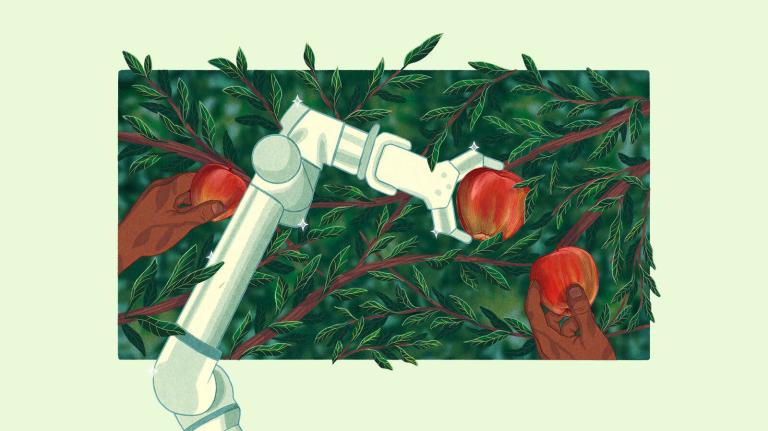 The farm bill, a massive Gordian knot of legislation that rolls through Congress every five years or so, has rolled into Congress. Not recently, mind you, it’s already been under discussion and in negotiation for a year. The bill touches nearly every aspect of America’s food system — and sucks in more than a few tangential issues as well. (If you’re new to the bill and its details, our page of posts on the topic is the best place to start. NPR also has a good overview.)
The farm bill, a massive Gordian knot of legislation that rolls through Congress every five years or so, has rolled into Congress. Not recently, mind you, it’s already been under discussion and in negotiation for a year. The bill touches nearly every aspect of America’s food system — and sucks in more than a few tangential issues as well. (If you’re new to the bill and its details, our page of posts on the topic is the best place to start. NPR also has a good overview.)
Right now, the Senate is considering the Agriculture Reform, Food and Jobs Act of 2012 (read: the farm bill, though ARFJA is also catchy). It left the Senate Agriculture committee and arrived on the Senate floor, where it was promptly peppered with over 90 amendments.
We went through and identified five of the 90 that are most worth paying attention to. If you have additions or questions, feel free to leave them in the comments; consider this a living document. As the bill progresses through the Senate and then the House — perhaps even before the existing legislation expires at the end of September — we’ll track its evolution and likely impacts.
1. Restoring funding to the Supplemental Nutrition Assistance Program
SNAP is the more recent, more elegant name for the government’s food stamp program — a program that the bill in front of the Senate would slash by $4.5 billion. This is a big problem, for about 4.5 billion reasons.
Sen. Kirsten Gillibrand (D-N.Y.) wrote an opinion piece for The Huffington Post outlining an amendment that would substantially restore that funding.
The fact is that food stamps are an effective investment. For every dollar that’s invested into the SNAP program, we get $1.71 back in return. This money pays the salaries of grocery clerks as well as the truckers who haul the food and produce across the country. In addition, the USDA estimates that 16 cents goes back to the farmer who grows the produce. As Moody’s economist Mark Zandi put it, “The fastest way to infuse money into the economy is through expanding the SNAP/food stamp program.”
Her amendment got a boost yesterday when Sen. Scott Brown (R-Mass.) agreed to cosign the legislation. In a still-polarized and filibuster-obsessed Senate, having a member of another party on board is an important asset.
2 and 3. Limiting subsidies to crop insurance
Since this is Washington, and it’s 2012, the theme of both the bill and many of the amendments is cutting costs. The version of the bill the Senate is looking at revises commodity payments — the long-criticized incentives for farmers to plant particular crops — in important ways. An important management tool for the food supply, they still exist, but have been refined to apply under more precise conditions.
In recent years, the heaviest farm subsidies shifted away from direct payments to commodity farmers and toward crop insurance premiums. Designed originally to provide insurance against failed crops, the recent “shallow loss” version of the premiums now essentially insure big farms’ income. A report from the Environmental Working Group determined that these premiums were a strong contributor to the growth of industrial farms, which often received a disproportionate amount of the benefit. In 2011, taxpayers shelled out $8.9 billion in premiums and insurers’ costs. (Point of contrast: NPR receives less than $4 million a year.)
Two amendments tackle premium reform, as noted at Agriculture.com:
One, introduced by Senators Tom Coburn (R-OK) and Dick Durbin (D-IL), would reduce premium subsidies by 15% for farmers (or legal entities) with adjusted gross income above $750,000. The limit would start with the 2014 reinsurance year.
The other approach, backed by Senators Jeanne Shaheen (D-NH) and Pat Toomey (R-PA) would limit subsidies for farmer premiums to $40,000 per year.
Without these or similar amendments, the premium system will likely remain as-is. Our food editor Twilight Greenaway discusses the need for reform more here.
4. Banning ownership of livestock by meatpackers
Food and Water Watch describes the problem:
Meatpackers increasingly own their own cattle in order to manipulate the market. The companies buy livestock on the open market when prices are low but slaughter their own livestock when bidding prices rise. This puts long-term, downward pressure on the price of livestock and allows meatpackers to manipulate what farmers and ranchers earn. These persistently low livestock prices effectively work to push small and medium-sized farmers out of business, while still leading to increased consumer food prices because large meatpackers don’t face enough competition to force them to pass on savings to consumers.
As written, the Senate bill doesn’t address this problem. A proposed amendment from Sens. Chuck Grassley (R-Iowa) and Kent Conrad (D-N.D.) would limit ownership of livestock to two weeks prior to slaughter.
For more on this issue, see this great post from last April in which Stephanie Ogburn talked to impacted ranchers.
5. Growing* a new generation of farmers
(* Also kind of a pun!)
Under the current version of the Senate bill, grants to beginning farmer training programs have not received the attention or funding they need. Why is this a problem?
By the time the next Farm Bill expires in five years, 125,000 American farmers will have retired. This fact may well be the biggest threat to national food security, but you wouldn’t know it if you’ve been following this year’s Farm Bill hearings.
With a generation of farmers retiring, all of the farmland in the world wouldn’t make a difference if no one knew how to farm it.
An amendment from Sen. Sherrod Brown (D-Ohio) would restore funding for young farmer programs, much to the appreciation of the National Young Farmers’ Coalition, which has been advocating for a similar measure.


